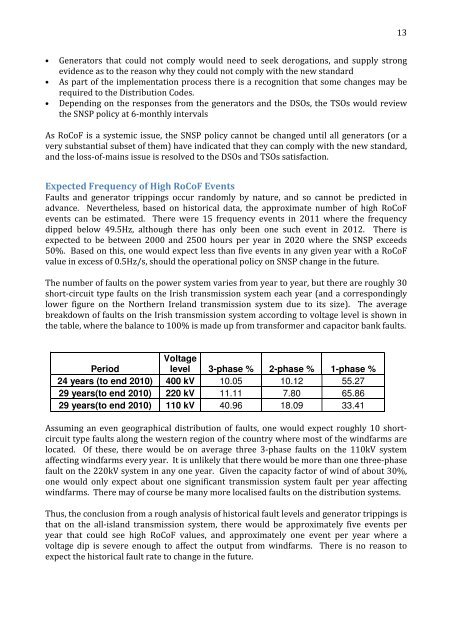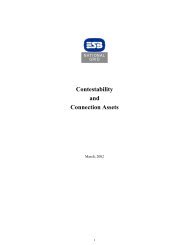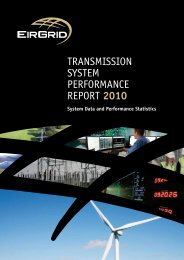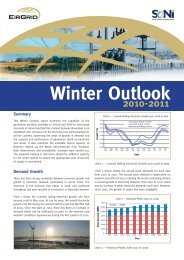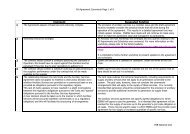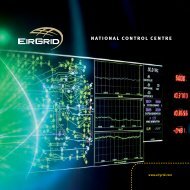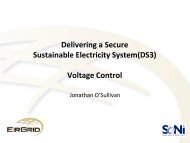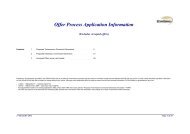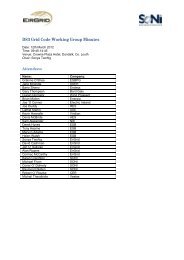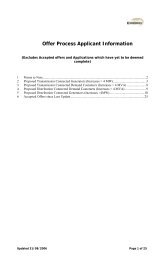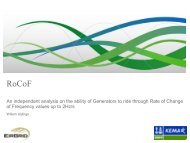RoCoF Modification Proposalâ TSOs' Recommendations - Eirgrid
RoCoF Modification Proposalâ TSOs' Recommendations - Eirgrid
RoCoF Modification Proposalâ TSOs' Recommendations - Eirgrid
Create successful ePaper yourself
Turn your PDF publications into a flip-book with our unique Google optimized e-Paper software.
13• Generators that could not comply would need to seek derogations, and supply strongevidence as to the reason why they could not comply with the new standard• As part of the implementation process there is a recognition that some changes may berequired to the Distribution Codes.• Depending on the responses from the generators and the DSOs, the TSOs would reviewthe SNSP policy at 6-monthly intervalsAs <strong>RoCoF</strong> is a systemic issue, the SNSP policy cannot be changed until all generators (or avery substantial subset of them) have indicated that they can comply with the new standard,and the loss-of-mains issue is resolved to the DSOs and TSOs satisfaction.Expected Frequency of High <strong>RoCoF</strong> EventsFaults and generator trippings occur randomly by nature, and so cannot be predicted inadvance. Nevertheless, based on historical data, the approximate number of high <strong>RoCoF</strong>events can be estimated. There were 15 frequency events in 2011 where the frequencydipped below 49.5Hz, although there has only been one such event in 2012. There isexpected to be between 2000 and 2500 hours per year in 2020 where the SNSP exceeds50%. Based on this, one would expect less than five events in any given year with a <strong>RoCoF</strong>value in excess of 0.5Hz/s, should the operational policy on SNSP change in the future.The number of faults on the power system varies from year to year, but there are roughly 30short-circuit type faults on the Irish transmission system each year (and a correspondinglylower figure on the Northern Ireland transmission system due to its size). The averagebreakdown of faults on the Irish transmission system according to voltage level is shown inthe table, where the balance to 100% is made up from transformer and capacitor bank faults.PeriodVoltagelevel 3-phase % 2-phase % 1-phase %24 years (to end 2010) 400 kV 10.05 10.12 55.2729 years(to end 2010) 220 kV 11.11 7.80 65.8629 years(to end 2010) 110 kV 40.96 18.09 33.41Assuming an even geographical distribution of faults, one would expect roughly 10 shortcircuittype faults along the western region of the country where most of the windfarms arelocated. Of these, there would be on average three 3-phase faults on the 110kV systemaffecting windfarms every year. It is unlikely that there would be more than one three-phasefault on the 220kV system in any one year. Given the capacity factor of wind of about 30%,one would only expect about one significant transmission system fault per year affectingwindfarms. There may of course be many more localised faults on the distribution systems.Thus, the conclusion from a rough analysis of historical fault levels and generator trippings isthat on the all-island transmission system, there would be approximately five events peryear that could see high <strong>RoCoF</strong> values, and approximately one event per year where avoltage dip is severe enough to affect the output from windfarms. There is no reason toexpect the historical fault rate to change in the future.


